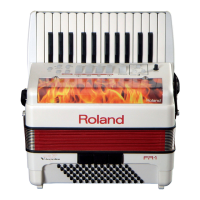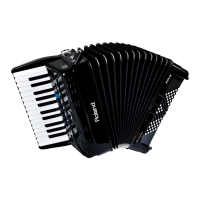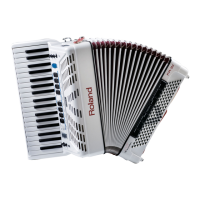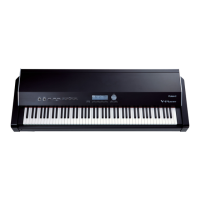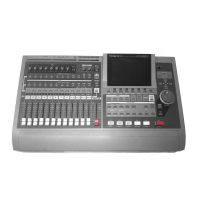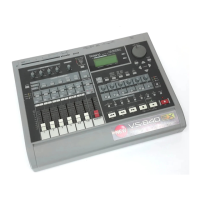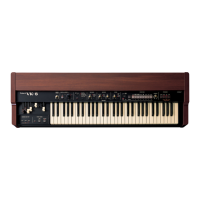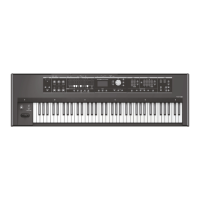Parameters
V-Accordion FR-18 diatonic
r
45
Chorus Type
Chorus broadens the spatial image of the sound, add-
ing richness. You can choose from 8 types of chorus.
The available options are:
Bellows Curve
This parameter allows you to adapt the FR-18
diatonic’s expressive potential to your playing style. If
you think the sounds don’t respond the way you
would like them to, try another curve that better
“translates” your movements.
There are three “Fixed” curves that always use the
same value, no matter how hard or lightly you push/
pull the bellows (no dynamic control). “Low” means
that a low value is used, “Med” represents a medium
value and “High” a high value.
The remaining settings do depend on the strength
with which you push/pull the bellows, but in differ-
ent ways: “Light” means that you do not need to
push/pull hard to achieve a meaningful effect. “X-
Light” requires even less strength (the “X” stands for
“extra”). “Standard” refers to a normal response.
“Heavy” provides a greater variety of nuances and
“X-Heavy” is even more detailed. It would be a good
idea to select each curve without the “Fixed” addi-
tion, play a few notes, select the next curve, etc. until
you find the response that feels just right.
Bellows Legato
This parameter only applies to percussive orchestral
sounds, like piano, guitar, xylophone, etc. It lets you
choose what kind of behavior is most suited to the
music you wish to play when you press and hold a
button while opening and closing the bellows.
Treble Valve Noise
You will probably agree that electronic sounds must
not only reproduce the basic timbre of an existing
signal, but also the original instrument’s behavior
and typical “noises” in order to be perceived as
authentic. In the case of a guitar that would be the
sliding noise of the fingers. An accordion, on the
other hand, produces mechanical valve noises that
cannot be suppressed on an acoustic instrument.
Use this parameter to specify how prominent the
noise produced by the simulated Treble valves should
be. The settings you can select with the registers are:
Chorus 1~4, FBack Chr, Flanger,
Short Delay, Short Dly FB
Default setting: Short
Delay
Type Explanation
Chorus 1
Chorus 2
Chorus 3
Chorus 4
These are conventional chorus
effects that add spaciousness and
depth to the sound.
FBack Chr This is a chorus with a flanger-like
effect and a soft sound.
Flanger This is an effect that sounds some-
what like a jet airplane taking off or
landing.
Short Delay This is a delay with a short delay
time.
ShortDly FB This is a short delay with many
repeats.
Register Value Register Value
1 Chorus 1 3• Short Delay
2 Flanger 4 ShortDly FB
Fixed Low, Fixed Med, Fixed High,
X-Light, Light, Standard, Heavy,
X-Heavy
Default setting:
Standard
Register Value Register Value
1 Fixed High 3• Standard
2 Light 4 Heavy
15
16
Off, On
Default setting: On
Register Setting Meaning
1 Off Percussive orchestral sounds
are controlled by the bellows.
When you change the direc-
tion of the bellows, the new
note will restart from the
beginning and sound percus-
sive.
2• On Percussive orchestral sounds,
like piano, vibe, guitar, and so
on, are played in a “legato”
fashion: when you change
the direction of the bellows
while holding a treble button,
the new note will be the con-
tinuation of the note you
started with the opposite bel-
lows direction. In most cases,
this means that the new note
will not sound very percus-
sive (no noticeable attack).
Off, –40~0~+40
Default setting: 0
Register Value Register Value
1 Off 3• 0
2 -20 4 +20
FR-18d GB.book Page 45 Wednesday, December 15, 2010 1:54 PM

